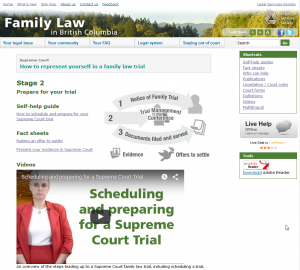An Introduction to BC Provincial Court Family Orders

In Provincial Court, you can get orders for: guardianship, parenting arrangements, child/spousal support, protection, and more.
See this page for general information and more resources on the BC Provincial Family Court process.
What is a court order?
An order is a statement of the court’s decision. It sets out what you and the other party (for example, you and your ex-spouse) must do.
Court orders must be prepared and filed, or “entered” into the Provincial Court Registry (click for locations).
Read the Legal Services Society (LSS) resource, “All about court orders” for more information about what kinds of court orders you can get, as well as options to pursue before the court makes a final order, to try and resolve as much of your case as possible without a formal court hearing.
Can I get a court order without a lawyer?
Yes.
If you and the other party agree about what you want the court to order, you can apply for what’s called a “consent order” and may be able to get it without attending court.
- If you have a lawyer, your lawyer will have the order typed and submit it to the Court. If you don’t have a lawyer, the other party’s lawyer will do this, but you should see a lawyer yourself to review the proposed order before you sign a document showing you consent to the order.
- Click here to see where to find free or low cost legal advice on family law matters.
- If you don’t have a lawyer, another direct way to get a consent order is to meet with a Family Justice Counsellor (FJC) who can help you obtain or change an order in Family Court. FJCs work at Family Justice Centres located across BC; they provide free services for people of modest means. FJCs are specially trained to support families to reach agreement on issues of guardianship, parenting arrangements (including parental responsibilities and parenting time), contact and support. They can help you obtain or change an order in Family Court; including preparing the consent order and submitting it to the Court for you. They can also provide information and referrals, short-term counselling, mediation, help with various court forms, and more. In some communities, couples who separate must meet with a FJC before they are given a date to appear in court.
- As a last resort, if you cannot meet with a Family Justice Counsellor or get help from a lawyer, it is possible to prepare a consent order yourself. This LSS Resource with Tips on how to draft a consent order contains links to the BC Provincial Court’s website, where you can access a “Picklist” WORDdoc including standard Family Law Act (FLA) terms to help you draft the order. (To “draft” an order means to choose the wording and type it. See also: What does the FLA deal with?) However, both parties should talk to a lawyer to make sure they understand what they’re agreeing to before signing their consent.
- “How to get a final family order in Provincial Court” explains what to do once you draft a consent order. If a judge approves your order, you won’t have to appear in a court room. However, if there are problems in the wording you choose or the information you provide, you may have to attend court to give the judge more information. This is why it’s so helpful to have a FJC or lawyer prepare and submit a consent order for you.

If, however, you and the other party ultimately don’t agree, you’ll go to court and the judge will make an order:
When?
- If both parties agree by the time you get to court you can ask the judge to make a consent order on the day of your first court appearance.
- When you go to court, you can ask for a case conference where you and the other party will meet with a judge to discuss the issues. If you agree during the case conference, the judge can make a consent order there.
- Your matter can be set for a hearing or trial or an interim application. The judge will make an order after considering evidence and submissions.
Who does the drafting in this case?
- This does not mean that the judge types up the order that is filed at the registry. The Rules require the successful party’s lawyer to do that.
- However, if you are successful and do not have a lawyer, the court clerk (registry staff) prepares the order unless the judge orders otherwise. For example, if the unsuccessful party has a lawyer, the judge may ask that lawyer to draft the order.
- If the other party’s lawyer will be preparing an order, ask the judge to permit you to approve its wording before the lawyer sends it to the Court.
- Whether an order is submitted by a lawyer or prepared by the court registry, it will be checked by court staff and/or the judge to ensure it reflects what the judge said in court.
How should the court order be drafted, and why?
The order should clearly and precisely reflect the court’s decision. It should state who does what, to whom, when, and in some cases where or for how long.
It should be understandable even by someone who is unfamiliar with the case. This is because the court’s orders may need to be enforced by people who were not involved in the case.

Poor Example of a term in an order:
John Smith will pay child support of $800 a month.
- There would be problems enforcing this order if John did not pay. It doesn’t say who he must pay or when, among other details missing.
Better Example of a term in an order:
John Smith will pay to Jane Smith the sum of $800 per month for the support of the children, May Smith born June 1, 2011 and Lee Smith born July 3, 2012, commencing on October 1st 2015 and continuing on the first day of each and every month thereafter, for as long as the children are eligible for support under the Family Law Act or until further Court order.
- This wording from the “Picklist” on the Provincial Court website makes it clear who does what to whom, when, when the obligation starts, and when it ends. Use the standard wording of Family Law Act terms provided in the BC Provincial Court Picklists whenever possible; this also helps with faster processing at the Registry: Click here for the Picklist Word Doc.
If a lawyer is involved, they will use their notes of what the judge said to draft the order. If the judge gives written reasons for judgment after trial, the order will be prepared based on these written reasons – you can also order clerk’s notes or a transcript of the proceeding, although this can take some time and is expensive.
The order can be in the following forms (Click here to access forms):
- Form 20 for consent orders (see what else you need to file – special requirements for applications of guardianship of children and child support),
- Form 25 for protection orders;
- Form 25.1 for restraining orders; and
- Form 26 for all other orders.






